Methods for determining soil acidity: how to find out the pH of the soil yourself (including weeds)
So, you decided to find out how to determine the acidity of your soil on the site, or purchased (or prepared) soil for growing seedlings. Indeed, soil acidity is a very important topic as this directly affects all garden and horticultural crops. Accordingly, in order to successfully grow them, you need to know the acidity of your soil.
Next, you will learn about all methods for determining the acidity of the soil, including purely folk (for example, weeds) and more professional (accurate) ones.

Content
What is soil acidity, what does it affect
If you read the classical definition of soil acidity, and this is "the ability of the soil to exhibit the properties of acids, caused by hydrogen ions," then for most summer residents it will not give anything.
Why is it important to know what is the acidity of the soil on your site?
As you know, for normal growth and development, most plants require neutral acidity soil (6-7 pH).
However! At the same time, many vegetable, fruit and berry crops are able to grow well on slightly acidic soils (up to pH 5.2).
The fact is that certain macro- and micronutrients bind and become practically inaccessible (difficult to digest) for plants at higher or lower levels of soil acidity (pH). Simply put, it happens nutritional deficiencies due to which plants stop growing and developing.
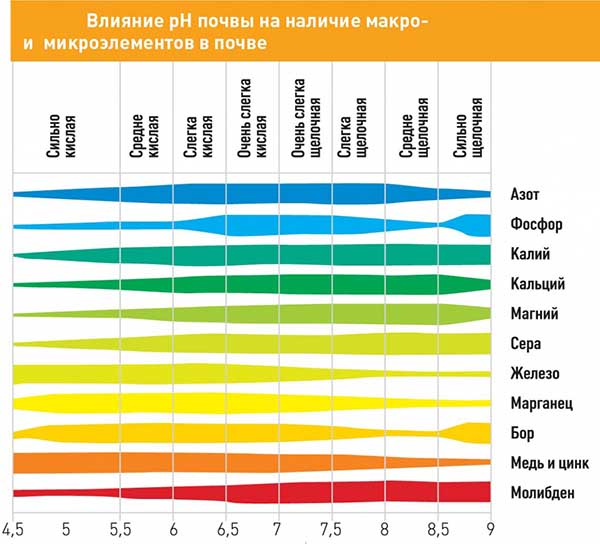
Also (as a rule, at an increased level), the solubility of toxic compounds (manganese, aluminum, iron, boron, etc.) increases and the physical properties of the soil deteriorate.
Soil acidity scale
Acidity is roughly high (alkaline soil), neutral and low (acidic), but the following scale is usually used:
- acidic (pH less than 4.5);
- medium acid (pH 4.5-5.2);
- slightly acidic (pH 5.2-5.5);
- close to neutral (pH 5.5-6);
- neutral (pH 6-7);
- slightly alkaline (pH 7-8);
- medium alkaline (pH 8-9);
- alkaline (pH above 9).
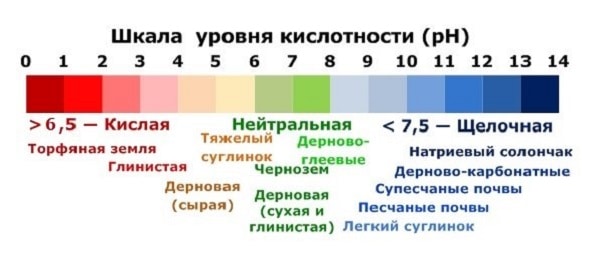
Note! There are plants that can grow and develop well only on slightly acidic and acidic soils... It:
- all cultures family heather — heathers, blueberry, blueberries, lingonberries, cranberries, azaleas and rhododendronsas well as erica;
- hydrangeas;
- some conifers.
Accordingly, each plant in your garden area needs to create the most suitable conditions, and first determine what the acidity of the soil is.
Video: checking the acidity of the soil is a very important indicator
Methods for determining the acidity of the soil
Let's start with the simplest, so to speak, folk methods, and end with more expensive, accurate and professional ones.
By plants (weeds) on the site
The easiest and completely free way to determine the acidity of the soil is to see which wild plants (in other words, weeds) are growing in your summer cottage.
- If the soil is acidic, then you should grow wild (horse) sorrel, plantain, oxalis, as well as caustic buttercup (creeping), veronica oak, horsetail, woodlice (other names are medium starweed or woodlice), sedge.
- Chamomile, clover, yarrow, cuff, and mother and stepmother are characteristic of neutral soils.
- If your soil is alkaline - wormwood, burdock, quinoa, white doze, poppy, field bindweed.
Note! In this case, only numerous plants (thickets) should be taken into account. If this is some kind of single case, then perhaps the seeds fell on the site by accident and in the next season nothing like this will grow on this place.
However, not every beginner or even an experienced summer resident will be able to correctly identify these indicator plants (the same horsetail or sedge), the more the result will be more than approximate, which means that the method can hardly be called indicative.
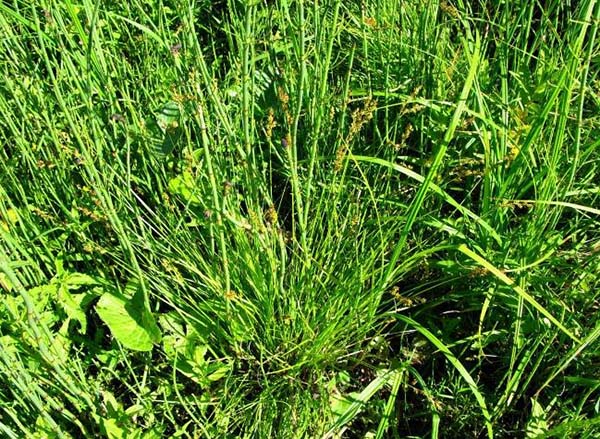
Interesting! Very often you can find a situation when horsetail, plantain, clover, bindweed and chamomile grow at the same time on a plot nearby.
Currant leaves are the most ineffective method
The most primitive way to determine acidity is to pour boiling water over currant leaves (2-3 leaves per 100 ml of boiling water), wait until the infusion cools down, and pour earth into it. If the soil is acidic, then the color of the solution should change to red (acquire a reddish-yellow tint, if neutral - green, alkaline - blue.
However! The mortar usually just takes on the color of your soil, so the way is absolutely pointless and non-working.
Using vinegar or soda
In both cases, first you need to prepare a soil solution (or just moisten the ground well with distilled water), and then add soda or vinegar to it (you can take 9%).
- If after adding soda solution starts sizzle and bubble (reaction will go), this means that the soil is acidic. If not very actively hiss and bubbles, it is slightly acidic or neutral. If nothing happens (everything is calm), then the reaction of the soil alkaline.
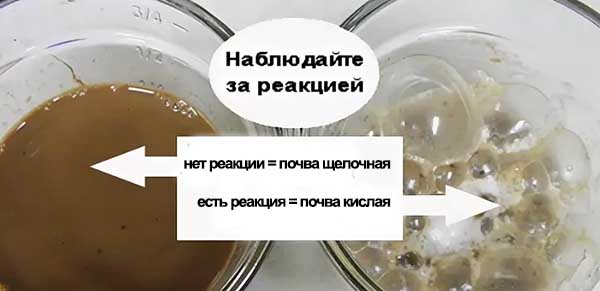
- If you added vinegar and the solution begins to foam strongly (a reactive reaction occurs), then the acidity of the soil is closer to alkaline. If it foams quite a bit, then it is slightly alkaline-neutral. If everything is calm (nothing happens), then the soil is acidic.

The method is really working and very indicative.
Anthocyanin solution - method from Ivan Russian and channel Procvetok
How to determine soil acidity using anthocyanins?
- So, first we need to take a vegetable or berry with a lot of anthocyanins, while it is best to focus on red cabbage (you can also use a variety of berries - blueberries, blackberries, blueberries, black currants, and cherries).
- Next, chop (thinly chop) 100 grams of red cabbage and knead with your hands.
- Pour 500 ml of water and let it brew for 2-3 hours, as a result you should get a dark purple solution.
- Now you need to prepare a soil solution: take 100 grams of soil and pour 200-250 ml of water (preferably distilled), again let it brew for a couple of hours, at the end filter through cheesecloth.
- Pour / mix 20-50 ml of dark purple anthocyanin solution of red cabbage with soil solution and look for a change in its color.
- The more pink the solution is, the more acidic it is.
- The more blue and green, the more alkaline the reaction.
More specifically, pink is pH 5-6, purple is pH 7, blue is pH 8, and green is pH 9.
Naturally, the method is not very accurate and rather rough, but it is quite possible to determine what kind of soil you have - acidic, neutral or alkaline.
Video: how to determine the acidity of the soil at home.
Test-indicator strips (litmus papers)
Perhaps the most optimal use of special test indicator strips (which are more often called "litmus tests").
How to measure soil acidity using litmus paper (test indicator):
- As a rule, the essence boils down to preparing a soil solution (for 1 part of the soil, take 4-5 parts of water, preferably distilled), let it brew and lower the indicator strip (litmus paper) into it for a few seconds, and then that appeared on it compare the color with a scale to obtain an approximate pH value.
- Or, alternatively, you can make a small hole in the soil (or in a pot with a houseplant), then spill it thoroughly with clean cold water (preferably distilled) and press the test indicator against damp soil.
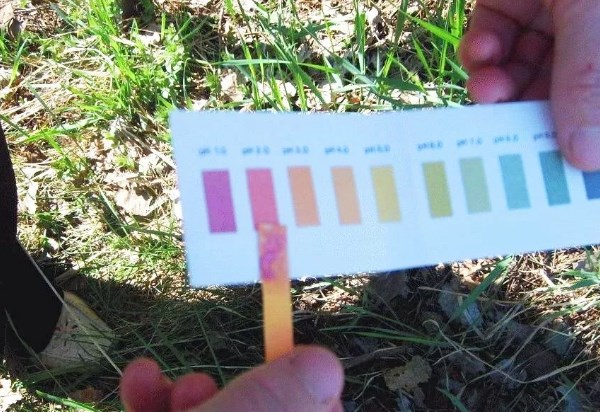
As for the cost, for example, the price for 80 pieces of Garden Show test litmus papers is only 199 rubles in Obi's store (as of January 2020).
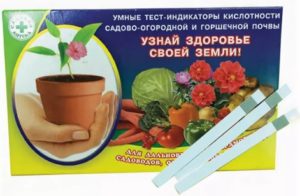
Nevertheless, litmus tests show an approximate value, but they are inexpensive and convenient to use (you do not need to prepare any special solutions and do home chemical experiments).
Video: measuring soil pH with litmus test strips
Electronic device (pH meter)
To obtain the most accurate result, you can use special electronic devices for measuring acidity (pH meters).
Advice! The most important thing when using such an electronic pH meter is to initially correctly calibrate the value, for which there is a special calibration solution.
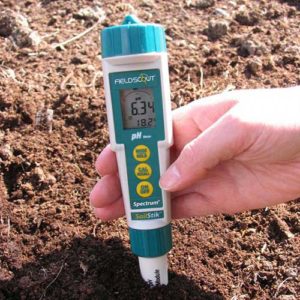
However, the prices for such devices will hardly please you, although they correspond to the quality (accuracy of the result).So, in the Leroy Merlin store, the simplest soil pH meter costs about 422 rubles (as of January 2020), however, its quality leaves much to be desired. The cost of a more or less serious device starts at 2202 rubles (as of January 2020). For example, this is the Multitester Green Helper PH 4 in 1 PH-300 in the VseInstrumenty.ru store.
However! On Aliexpress, you can find a quite suitable option for 300 rubles (in the picture below).
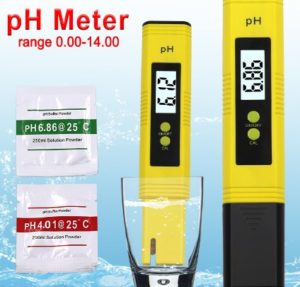
Professional biochemical laboratory
Of course, you can get the most complete information only in a professional laboratory. However, does it make sense to carry the garden land to such a place? The procedure is not cheap. It is one thing if you are a farmer with several tens of hectares of land, quite another is an amateur gardener with 6-12 acres.
How to change soil acidity
You have determined the acidity, which means you can move on to real actions - to acidification (decrease in pH) or deoxidation of the soil (increase in pH).
Most often, gardeners are faced with the fact that the soil in their garden is too acidic, which means that it needs to be deoxidized (increased pH). To do this, you need to add one of the deoxidizers to the soil, they also say to lime it (while the application rates depend on the acidity level of the pH of your soil and its type (mechanical composition):
Use of dolomite (limestone) flour - This is the most popular way to deoxidize the soil.
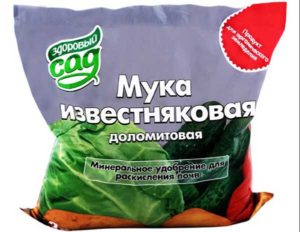
- wood ash;
- slaked lime (fluff);
- a piece of chalk;
- any other special deoxidizer (for example, Lime-Gumi).
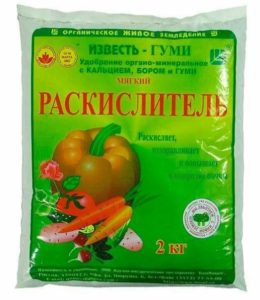
If you want to increase the acidity of the soil, then you need to add more high-moor sour peat, gypsum, aluminum, magnesium or ammonium sulfate (nitrogen fertilizer) to it, as well as sulfur.
Advice! More details about how to change soil acidity, told in this separate article.
Thus, every gardener can easily enough find out the acidity of the soil at his summer cottage in order to correct it correctly so that the plant can grow well and develop actively.
Video: how to determine the acidity of the soil

